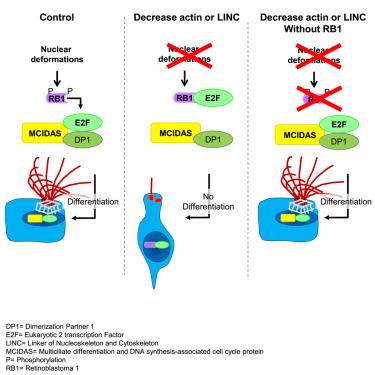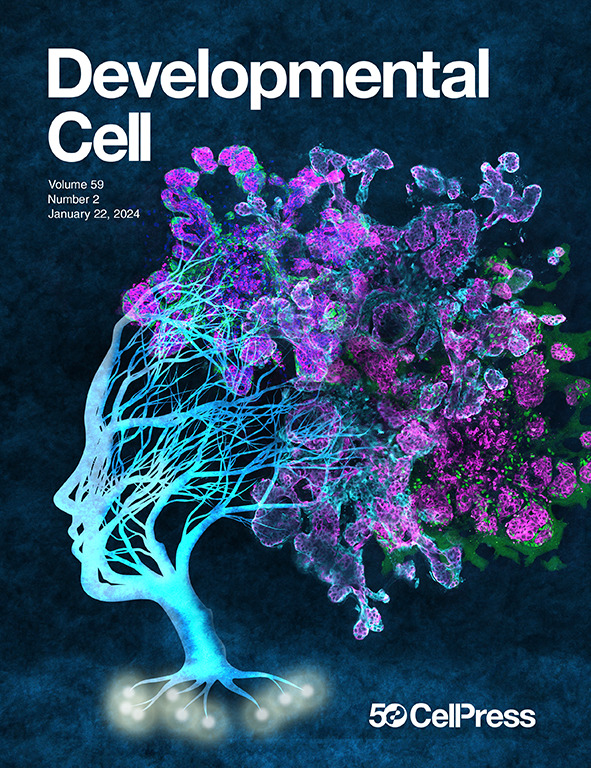基于肌动蛋白的细胞核变形控制着小鼠多纤毛上皮细胞的分化
IF 8.7
1区 生物学
Q1 CELL BIOLOGY
引用次数: 0
摘要
室管膜细胞(ECs)是大脑中的多分枝细胞,有助于脑脊液的流动。内皮细胞在胚胎阶段被指定,但在发育后期分化。它们的分化取决于GEMC1和MCIDAS等基因以及E2F4/5以及细胞周期相关因子。在小鼠大脑中,我们观察到细胞核变形伴随着EC分化。通过降低f -肌动蛋白水平或切断细胞核和肌动蛋白细胞骨架之间的联系来改变这些变形会阻碍分化。相反,通过敲除Arp2/3复合物抑制剂Arpin或人工使细胞核变形来增加F-actin可激活分化。这些数据与肌动蛋白聚合触发核变形和启动产生ec的信号一致。这一过程的参与者是视网膜母细胞瘤1 (RB1)蛋白,其磷酸化促进MCIDAS激活。总的来说,本研究确定了肌动蛋白为基础的机械输入到细胞核作为细胞分化的控制因素的作用。本文章由计算机程序翻译,如有差异,请以英文原文为准。

Actin-based deformations of the nucleus control mouse multiciliated ependymal cell differentiation
Ependymal cells (ECs) are multiciliated cells in the brain that contribute to cerebrospinal fluid flow. ECs are specified during embryonic stages but differentiate later in development. Their differentiation depends on genes such as GEMC1 and MCIDAS in conjunction with E2F4/5 as well as on cell-cycle-related factors. In the mouse brain, we observe that nuclear deformation accompanies EC differentiation. Tampering with these deformations either by decreasing F-actin levels or by severing the link between the nucleus and the actin cytoskeleton blocks differentiation. Conversely, increasing F-actin by knocking out the Arp2/3 complex inhibitor Arpin or artificially deforming the nucleus activates differentiation. These data are consistent with actin polymerization triggering nuclear deformation and jump starting the signaling that produces ECs. A player in this process is the retinoblastoma 1 (RB1) protein, whose phosphorylation prompts MCIDAS activation. Overall, this study identifies a role for actin-based mechanical inputs to the nucleus as controlling factors in cell differentiation.
求助全文
通过发布文献求助,成功后即可免费获取论文全文。
去求助
来源期刊

Developmental cell
生物-发育生物学
CiteScore
18.90
自引率
1.70%
发文量
203
审稿时长
3-6 weeks
期刊介绍:
Developmental Cell, established in 2001, is a comprehensive journal that explores a wide range of topics in cell and developmental biology. Our publication encompasses work across various disciplines within biology, with a particular emphasis on investigating the intersections between cell biology, developmental biology, and other related fields. Our primary objective is to present research conducted through a cell biological perspective, addressing the essential mechanisms governing cell function, cellular interactions, and responses to the environment. Moreover, we focus on understanding the collective behavior of cells, culminating in the formation of tissues, organs, and whole organisms, while also investigating the consequences of any malfunctions in these intricate processes.
 求助内容:
求助内容: 应助结果提醒方式:
应助结果提醒方式:


